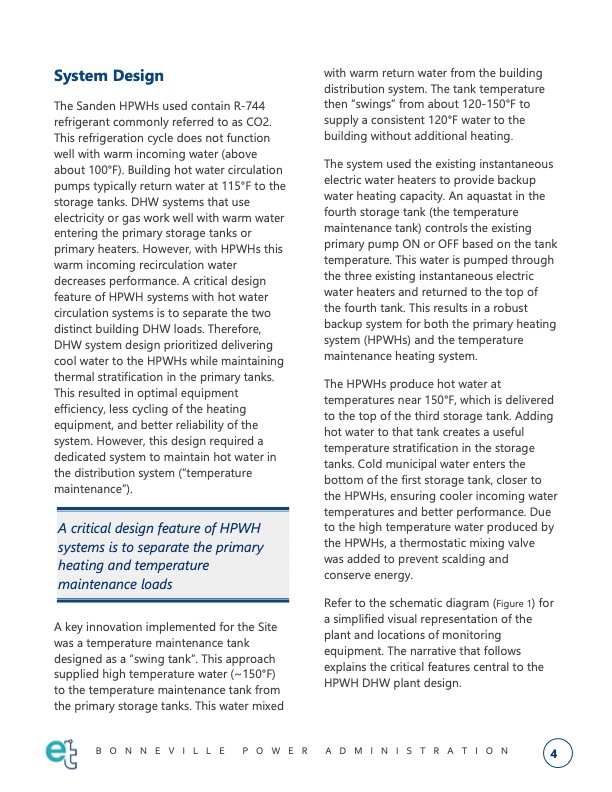
PDF Publication Title:
Text from PDF Page: 010
System Design The Sanden HPWHs used contain R-744 refrigerant commonly referred to as CO2. This refrigeration cycle does not function well with warm incoming water (above about 100°F). Building hot water circulation pumps typically return water at 115°F to the storage tanks. DHW systems that use electricity or gas work well with warm water entering the primary storage tanks or primary heaters. However, with HPWHs this warm incoming recirculation water decreases performance. A critical design feature of HPWH systems with hot water circulation systems is to separate the two distinct building DHW loads. Therefore, DHW system design prioritized delivering cool water to the HPWHs while maintaining thermal stratification in the primary tanks. This resulted in optimal equipment efficiency, less cycling of the heating equipment, and better reliability of the system. However, this design required a dedicated system to maintain hot water in the distribution system (“temperature maintenance”). A key innovation implemented for the Site was a temperature maintenance tank designed as a “swing tank”. This approach supplied high temperature water (~150°F) to the temperature maintenance tank from the primary storage tanks. This water mixed with warm return water from the building distribution system. The tank temperature then “swings” from about 120-150°F to supply a consistent 120°F water to the building without additional heating. The system used the existing instantaneous electric water heaters to provide backup water heating capacity. An aquastat in the fourth storage tank (the temperature maintenance tank) controls the existing primary pump ON or OFF based on the tank temperature. This water is pumped through the three existing instantaneous electric water heaters and returned to the top of the fourth tank. This results in a robust backup system for both the primary heating system (HPWHs) and the temperature maintenance heating system. The HPWHs produce hot water at temperatures near 150°F, which is delivered to the top of the third storage tank. Adding hot water to that tank creates a useful temperature stratification in the storage tanks. Cold municipal water enters the bottom of the first storage tank, closer to the HPWHs, ensuring cooler incoming water temperatures and better performance. Due to the high temperature water produced by the HPWHs, a thermostatic mixing valve was added to prevent scalding and conserve energy. Refer to the schematic diagram (Figure 1) for a simplified visual representation of the plant and locations of monitoring equipment. The narrative that follows explains the critical features central to the HPWH DHW plant design. A critical design feature of HPWH systems is to separate the primary heating and temperature maintenance loads BONNEVILLE POWER ADMINISTRATION 4PDF Image | CO2 Heat Pump Water Heater Multifamily Retrofit

PDF Search Title:
CO2 Heat Pump Water Heater Multifamily RetrofitOriginal File Name Searched:
co2-heat-pump-water-heater-final.pdfDIY PDF Search: Google It | Yahoo | Bing
CO2 Organic Rankine Cycle Experimenter Platform The supercritical CO2 phase change system is both a heat pump and organic rankine cycle which can be used for those purposes and as a supercritical extractor for advanced subcritical and supercritical extraction technology. Uses include producing nanoparticles, precious metal CO2 extraction, lithium battery recycling, and other applications... More Info
Heat Pumps CO2 ORC Heat Pump System Platform More Info
| CONTACT TEL: 608-238-6001 Email: greg@infinityturbine.com | RSS | AMP |